Japan
Wood Products Prices
Dollar Exchange Rates of 25th
June
2025
Japan Yen 144.40
Reports From Japan
Business sentiment turns negative – first
time in 5
months
A government survey shows that business sentiment at
major Japanese firms has turned negative for the first time
in five quarters. This comes amid concerns about the
impacts of new US tariffs. A negative result indicates that
a majority of companies feel business conditions have
worsened. About 11,000 companies responded to the
quarterly survey by the Finance Ministry and the Cabinet
Office.
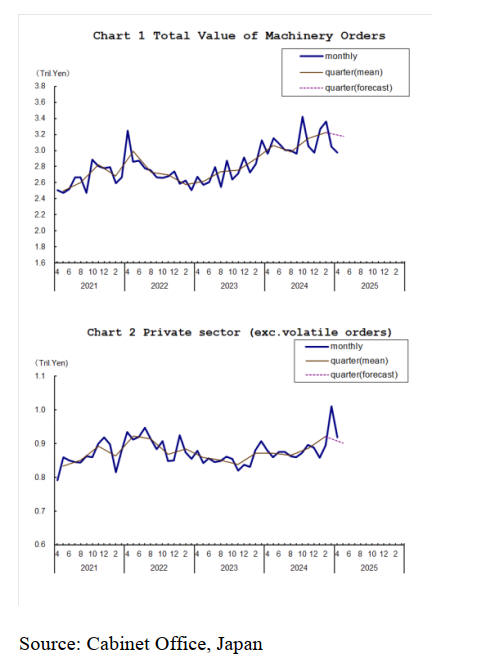
The index for manufacturers stood at minus 4.8, marking a
second straight quarter with a negative figure. However
the index is projected to swing to positive territory in the
July to September period as robust demand in the chip
sector and brisk inbound tourism will likely push it up.
The total value of machinery orders received by top
manufacturers operating in Japan decreased 2.3% in April
from the previous month on a seasonally adjusted basis.
Private-sector machinery orders, excluding those for ships
and those from electric power companies, decreased a
seasonally adjusted by 9.1% in April.
See: https://www3.nhk.or.jp/nhkworld/en/news/20250612_B4/
Japan not in a good position to absorb energy shocks
Japan’s economy is particularly vulnerable to conflicts in
the Middle East and the current crisis comes at a time
when Japan is not in a good position to absorb energy
shocks. According to the Petroleum Association of Japan,
about three-quarters of the country's crude oil imports are
shipped via the Strait of Hormuz and recently Iran
threatened to close the strategic passage.
Yuki Togano, a researcher at the Japan Research Institute,
has been reported as saying “a large portion of crude oil
and gas is transported through this strait, so any disruption
would hinder energy procurement and cause prices to
increase sharply."
Bank of Japan concerned on outlook for the economy
Bank of Japan (BoJ) governor, Kazuo Ueda, has expressed
concern on the outlook for the Japanese economy
following US tariff hikes saying downside risks now
"exceed" upside ones for both growth and prices. At a
press conference after the BoJ ended its recent two-day
meeting Ueda also said the Bank will continue raising
interest rates as needed but added, "overseas trade policies
pose a downside risk."
He warned that the economic impact of tariffs may
intensify later this year, saying the duties on the auto
sector, one of Japan's major exports are likely to affect
how the central bank proceeds with its monetary policy.
Japan's economy shrank an annualised real 0.2% in the
January-March period, the first contraction in a year,
underscoring that domestic demand was sluggish even
before US tariff threats took full effect.
Core consumer prices, meanwhile, rose 3.5% from the
previous year in April increasing at the fastest pace in
more than two years against a backdrop of rising material
costs and surging rice prices.
See:
https://mainichi.jp/english/articles/20250617/p2g/00m/0bu/0490
00c
New economic policy focused on wages
The Japanese government adopted a policy focused on
wage increases which includes a target of approximately
1% ‘real’ pay growth annually over five years to
encourage consumer spending. Japan's inflation-adjusted
wages have been mostly negative in recent years failed to
keep pace with rising prices, particularly for food and
energy. The result dampened private spending which
accounts for more than half of the country's GDP.
Despite calls from opposition parties for tax cuts to spur
consumption the government aims to support disposable
income through "pay growth rather than tax reductions" in
a bid to avoid a potential decline in state revenues.
See:
https://www.ntv.co.jp/englishnews/articles/2021t12x02i5e64aszil
.html
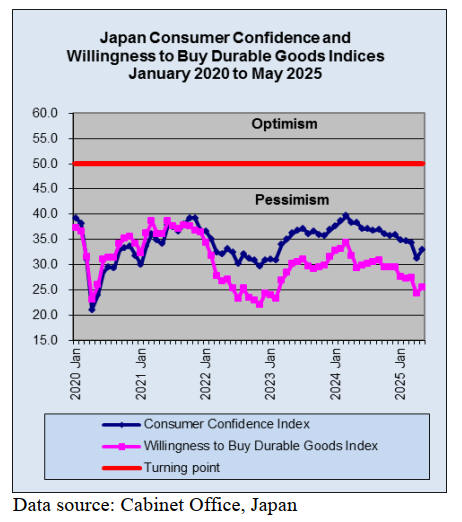
Yen likely to strengthen more
Recent discussion at the Bank of Japan's (BOJ)
highlighted the debate between caution and those pushing
for aggressive rate hikes to combat inflation. If the hawks
prevail then investors will rethink their exposure to yen-
denominated assets. The yen has already surged 8% year-
to-date and is likely to advance further. So far this year
consumer prices grew more than 2% for the first time in
decades and wage growth was positive. The hawks in the
BoJ argue the risk of inflation reversing is small given
rising rent, public service costs and food prices such that
rate normalisation is possible.
See: https://www.ainvest.com/news/yen-turn-japan-rate-hikes-
signal-golden-opportunity-2506/
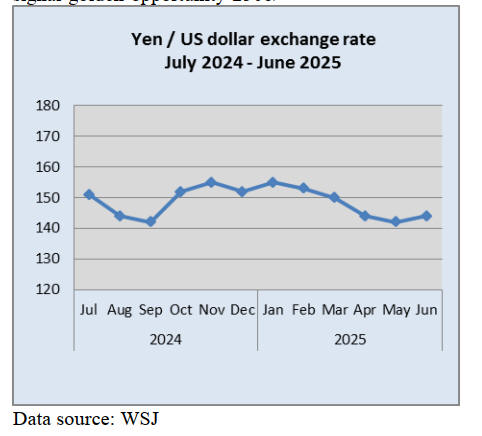
Property values rising
Japan's real estate market is currently experiencing a
period of growth, with land prices rising and property
values increasing, particularly in urban areas. However,
the market also faces challenges, including a high number
of vacant homes and a shrinking population.
Japan embraces timber for large structures
Wooden architecture in Japan is evolving. Previously used
primarily for low-rise buildings, timber is being used to
construct taller and larger structures. As the country aims
to cut carbon emissions by 60% by 2030 and reach net
zero by 2050, wood is re-emerging as a green alternative
to steel and concrete.
Kengo Kuma used certified wood from all 47 prefectures
in Japan for his iconic National Stadium, the main venue
of the 2020 Tokyo Olympics. This year, another global
event features its own wooden superstructure. The
pavilions of the Expo 2025 in Osaka are surrounded by a
20 metre high ring that is two kilometers in circumference.
Designed by Sou Fujimoto, the ring incorporates wood
from the Fukushima areas hit hardest by the 2011
earthquake, tsunami and nuclear disaster.
In Yokohama, Port Plus is Japan’s first all-timber fire-
resistant high-rise building. The columns are said to be fire
resistant for up to 3 hours. Earthquake resistance is also a
common point of contention for wooden buildings but Port
Plus achieves high seismic performance by incorporating a
earthquake isolation technology.
See: https://metropolisjapan.com/why-wooden-architecture-is-
making-a-comeback-in-japan/
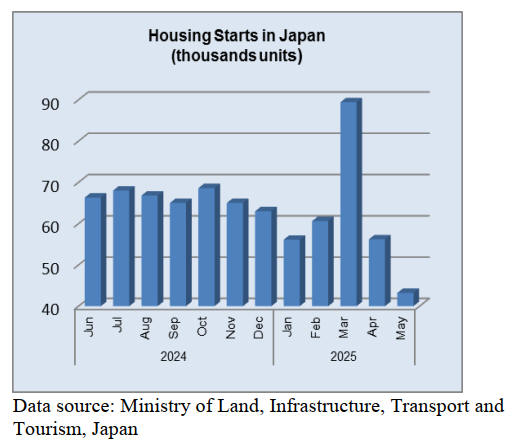
Wooden furniture import update
In Japanese culture there is a long held appreciation of
wooden furniture, valuing its natural beauty,
craftsmanship and connection to nature. This appreciation
is reflected in both traditional and modern Japanese homes
where wooden furniture is often seen as a way to add
‘warmth’, elegance and a sense of harmony to living
spaces. Japanese design philosophy often emphasises
harmony with nature and wood embodies this connection.
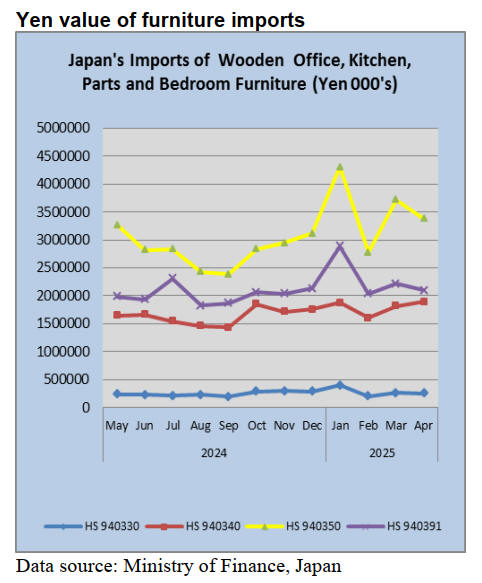
April wooden office furniture imports (HS 940330)
In April shippers in China accounted for 83% of Japan’s
imports of wooden office furniture (HS 940330) the other
two significant sources were Poland (5%, up from a month
earlier) and Malaysia (3%, down from a month earlier).
These three shippers accounted for over 90% of April
arrivals. The other source of wooden office furniture
imports was EU member countries (around 9%) with the
balance coming from Canada and the US.
Year on year, the value of Japan’s imports of wooden
office furniture in April was down 8% and compared to
the value of March arrivals there was little change.
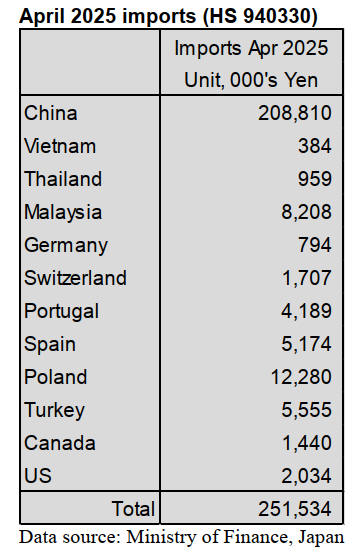
April wooden kitchen furniture imports (HS
940340)
As in previous months imports of wooden kitchen
furniture (HS 940340) were dominated by shippers in the
Philippines and Vietnam which together accounted for
over 70% of the value of April.
Shippers in the Philippines accounted for around 42%% of
total arrivals in April, down from a month earlier. Imports
from shippers in Viet Nam accounted for a further 29%
also down slightly month on month. The other shippers of
note in April were Thailand, China and Germany which
together accounted for around 24% of the value of
HS940340 imports.
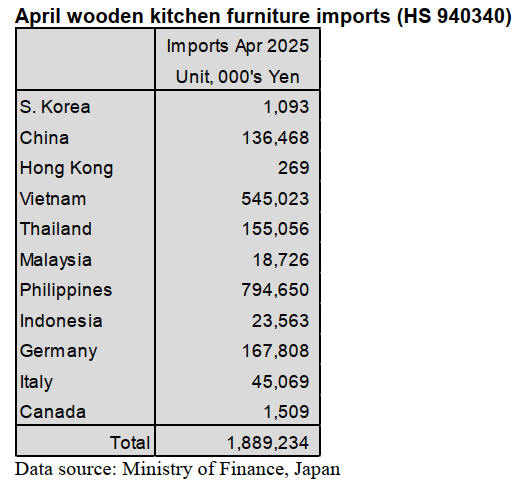
April arrivals from China were around 7% higher than
in
March. April shipments of wooden kitchen furniture
surged, lifting Germany to the third highest monthly
shipper. Compared to a year earlier the value of April
2025 imports were up 22%, marking a further increase in
the value of arrivals since February this year.
April wooden bedroom furniture imports (HS 940350)
From the start of 2025 the comparative monthly values of
imports of wooden bedroom furniture have been unusually
erratic compared to previous years. The average value of
arrivals of HS 940350 in the first four months of 2025 is
significantly higher than the average for the last four
months of 2024 and was above the average reported in the
first four months of 2024.
The top two shippers of (HS 940350) to Japan in April
2025 were China (56%) and Vietnam (36%), both down
slightly from a month earlier. Malaysia was the other
shippers of note in April accounting for a 3% share of the
value of imports. While the value of April arrivals of HS
940350 were at around the same levels as in April 2024
there was a 9% decline compared to a month earlier.
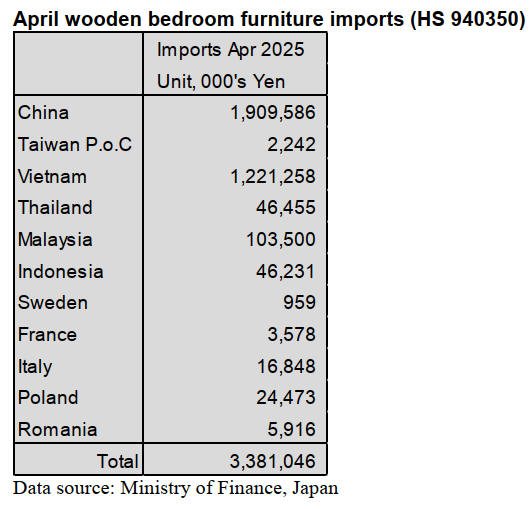
April wooden furniture parts imports (HS 940391)
After the January surge in the value of wooden furniture
parts (HS 940391) the value of monthly shipments has
steadied.
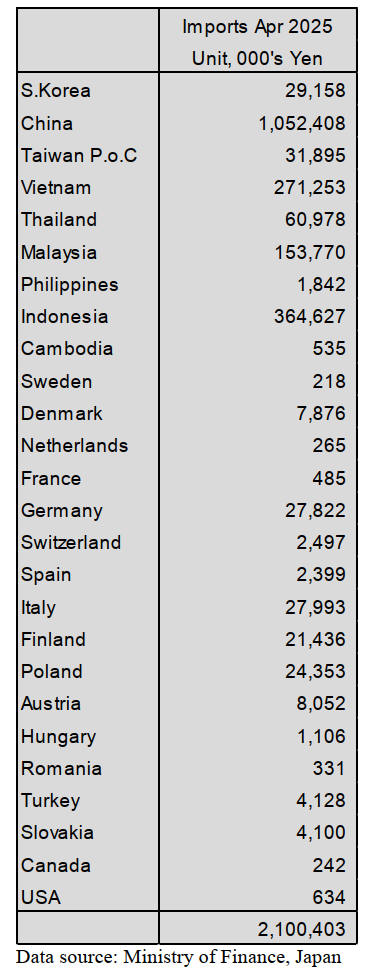
The value of April 2025 imports was almost the same as in
April 2024 but compared to a month earlier March 2025
the value of imports dropped around 5%.
Shippers in China, Indonesia and Viet Nam accounted for
most of Japan’s imports of wooden furniture parts (HS
940391) in April 2025.
Of the total value of HS 940391 imports 50% was
delivered from China (48% in March) 17% from Indonesia
(unchanged from March), 13% from Viet Nam 11% in
March) and Malaysia which captured a 7% share of the
value of April imports.
The value of imports of HS 940391 from Italy dropped
further in April. In contrast, shippers in Finalnd, Poland
and Austria shipped more in April than seen over the past
months.
Trade news from the Japan Lumber Reports (JLR)
The Japan Lumber Reports (JLR), a subscription trade
journal published every two weeks in English, is
generously allowing the ITTO Tropical Timber Market
Report to reproduce news on the Japanese market
precisely as it appears in the JLR.
For the JLR report please see:
https://jfpj.jp/japan_lumber_reports/
Exports of Japanese cedar structural lumber
The Japan Wood Products Export Association announced
on May 22, 2025 that the American Lumber Standard
Committee (ALSC) approved the design strength of
Japanese cedar 2×4 structural lumber on April 3, 2025.
This marks the second approval, following the
certification of Japanese cypress in April last year. The
groundwork for exporting key domestic lumber products
to the U.S. market is steadily advancing.
Japan has adopted a policy to strengthen export promotion
for agricultural, forestry, and fishery products. In the
forestry sector, it is laying the groundwork for exporting
value-added products such as fencing materials, decking
materials, and structural lumber for buildings, alongside
other key wood products.
The Forestry Agency and the Ministry of Agriculture,
Forestry, and Fisheries launched multiple subsidy
programs in fiscal year 2021. The Japan Wood Products
Export Association served as the application window,
leading to the selection of projects such as strength testing
for Japanese cedar and cypress structural lumber.
Sumitomo Forestry to begin producing SAF feedstock
Sumitomo Forestry Co., Ltd. in Tokyo Prefecture and
Rengo Co., Ltd. in Osaka Prefecture plan to establish a
joint venture by December to produce bioethanol, a
feedstock for sustainable aviation fuel (SAF), using wood
scraps and other construction waste.
The joint venture aims to establish mass production
technology early, targeting an annual commercial
production of 20,000 kiloliters of wood-based bioethanol
by 2027.
The two companies have signed a basic agreement on
business and capital partnership for the bioethanol project
and will continue discussions. However, details of the
joint venture have not yet been disclosed.
The production of bioethanol will utilize technology from
Biomaterial in Tokyo Co., Ltd. in Fukuoka Prefecture, a
subsidiary of Rengo specializing in research and
development of biomass-based chemical products.
The bioethanol production facility will be constructed
within the premises of Taiko Paper MFG Ltd. in Shizuoka
Prefecture, a subsidiary of Rengo that specializes in
packaging paper production and recycling.
Sumitomo Forestry will collect construction waste from its
housing construction sites in Shizuoka Prefecture and
nearby regions and supply CORSIA-certified waste chips
to Taiko Paper MFG.
Plywood
Domestic softwood plywood lacks strong market
movement, particularly through the lumber and
construction channels, while demand from precutting
plants remains stable.
The rush of orders before the implementation of
revised
building regulations in April led to an increase in housing
starts in March, contributing to a rise in orders at precut
factories.
The price of 12 mm 3 x 6 domestic softwood structural
plywood increased slightly in May in the Tokyo
metropolitan area rising to ¥1,080– 1,100 per sheet,
delivered to wholesalers, up ¥10–20 from the previous
month.
Major domestic plywood manufacturers argue that
production remains unprofitable and have announced
plans for another ¥50 increase in June.
Imported South Sea plywood saw a decline in shipments
to the Kanto region in May, but the market has yet to
experience extreme shortages. Despite the strengthening
yen, ongoing price increases in Malaysia— particularly for
12mm plywood— indicate a potential for further price
hikes. The price of 12 mm 3 x 6 painted formwork
plywood is ¥1,850 per sheet delivered to wholesalers.
Standard formwork plywood is ¥1,550 per sheet.
Structural plywood is ¥1,550 per sheet. 2.5 mm plywood
is ¥780 per sheet. 4mm plywood is ¥930 per sheet, and
5.5mm plywood is ¥1,100 per sheet.
Malaysian plywood manufacturers in Sarawak continue to
push for higher prices due to rising log costs, increased
minimum wages, and a stronger local currency.
Some contracts in May saw a price increase of US$10 per
cubic metre (C&F).
Meanwhile, in Indonesia, shortages in falcata and natural
wood logs are driving calls for price hikes, though the
current price levels remain stable. 12 mm 3 x 6 painted
formwork plywood is US$590–US$600 per cbm, C&F.
Standard formwork plywood is US$500-510. Structural
plywood is US$510–520. 2.4 mm plywood is US$970.
3.7mm plywood is US$880, and 5.2mm plywood is
US$850, with some lower prices observed.
|